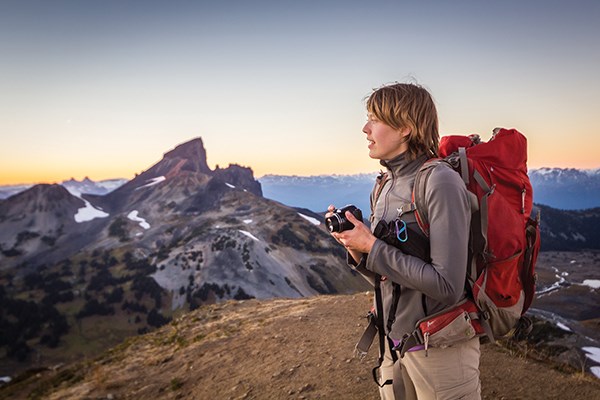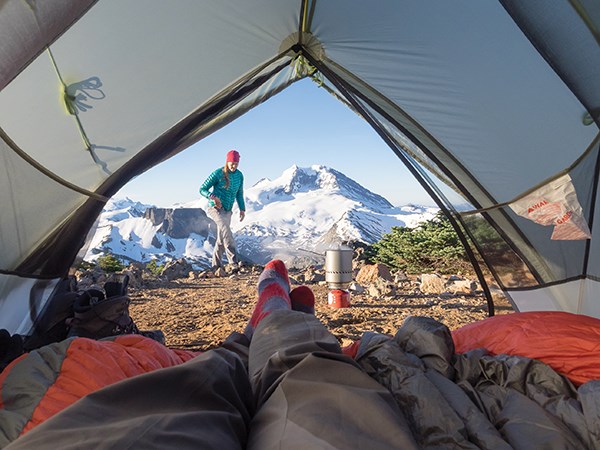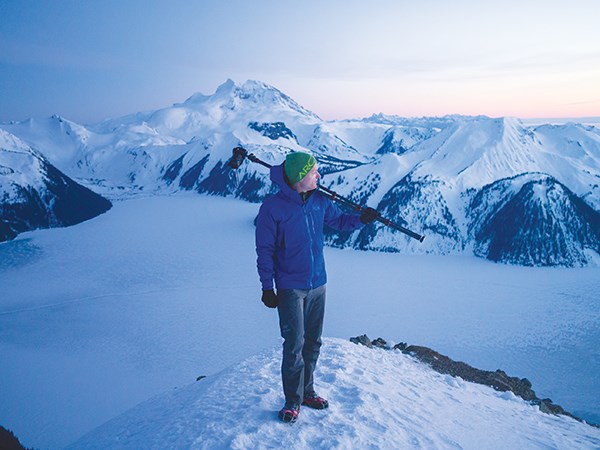Surrounded by mountains and wilderness in Squamish, we’ve likely all experienced this moment: You’ve hiked to the top of a peak or you’re driving Highway 99 to Whistler and you see an amazing sunrise at the Tantalus Viewpoint.
You stop what you are doing, awestruck by the majesty of the natural spectacle unfolding before your eyes. You take out your camera or phone and – click – take a photo, confident that you’ve captured that moment well. This will definitely be an image you will be proud to hang on your wall.
Later, when describing that moment to friends and family you take out your camera or phone, bring up the image and suddenly it doesn’t look that good anymore. You brush it off with, “Well, my camera really isn’t that good but you get the idea right? It really was amazing!”
But here’s the truth: When a photograph does not live up to your expectations, it usually has very little to do with the camera you are using and everything to do with how and why you took that photo in the first place.��The good news is I can give you some advice and tips on how to take better photos when you are out hiking, camping or viewing wild places.
��
1. Shoot what it feels like, not what it looks like.
Most of us use cameras as a means of simply journalling the experiences and memories that we see with our eyes. They are the modern versions of written diaries. We take snapshots of everything from food we eat and pets being funny to selfies with our friends.��
But a change needs to occur when we want to capture a feeling. When we are out in the cold mountains beside a roaring waterfall or watching the dying light of the day at sunset, the emotions we are feeling greatly outweigh simply what we are looking at.
The reason it’s so easy to identify the photography of professionals is that they have mastered the skill of making you feel the emotion in that moment with a single picture.
This is likely the number one reason your images, when viewed later, don’t live up to what you imagined they would while you were shooting them.��
In that moment you likely felt elated, content, happy or overwhelmed, but instead of trying to capture those emotions, you took a photo of the location where you happened to be standing.��
It’s crucial to break this routine we have learned as tourists in the past, of using a camera to catalogue the locations we visit, if we wish to truly make a photo that we’d be happy to hang on our walls.��
To do this, focus on what it is about the location that affects your emotions. Maybe it’s the laughter of friends, maybe it’s the cold wind scraping spindrift off nearby ridges, maybe it’s the exposure near a cliff or the way the changing light at dawn casts golden shadows across the ground.��
Ask yourself, “What am I feeling right now?” and work to capture that. If your image brings you back to that moment when you view it later, you will have succeeded.��

2. Don’t focus on the camera. Focus on the light.��
All too often a photographer will endure the remark, “You take great photos. You must have a good camera.” It’s important to remember that, aside from a few specific styles of photography, the camera doesn’t play nearly as big a part in how an image turns out as most people believe it does.��
I personally do not use a large DSLR camera. I use a smaller, mirrorless camera for the majority of my photography. I also use the camera on my phone more often than I would like to admit.��
The most important component that goes into making a great photograph is the eye and mind of the photographer, and a trained eye focuses on the light.��
Outside of a photo studio, we all rely on natural light for our photographs. Focus on how the clouds break up the sunlight and create shadows, how the hues change at dawn and dusk. Look for places in the environment with stark contrasts between light and dark.��
Follow the light always with your eyes. It shifts dramatically from moment to moment, so when it is perfect, take the shot.
��
3. Change your perspective.��
Another simple way to improve your photography is to shift your perspective. Humans are very visual creatures, and we tend to focus mainly on what we are seeing from eye height. If we were to flick through our volumes of images, we’d likely see that almost all of them have been shot from the same perspective, with the camera held up to our eyes.��
But when we are out in the mountains, all of our senses are active. We feel the texture and ruggedness of the trail underneath our boots, hear the sounds of the birds in the canopy above, smell the wild alpine flowers blooming. Change your perspective to visualize these other senses, shoot close to the ground and maybe capture the boots of your friends walking by, shoot upwards at the tree canopy above.��If you hear a squirrel in a tree, try to visualize what their world is like by capturing the texture of the bark on the trees near you.��
The rule is simple: Move the camera around and don’t lock yourself to shooting always from a standing eye height.��
��
4. Be there.��
One of the most important lessons of all is to not let the process of taking a photograph distract you from being present in the moment. Remember why you are there in those wild places, why you put in that effort to climb that mountain or visit that remote lake.
It can be easy to focus on what our camera is doing, what others might think of the images later and whether we’re taking the right photo. With digital cameras, we can shoot endlessly for hours on end without ever filling up our memory cards.
Be in the moment – if the light isn’t right just yet for the photo, don’t take it. Wait. Be patient.��
Don’t let your freedom to take as many photos as you can lead you to actually taking as many photos as you can.��Take the photos that will mean something to you, and when the moment isn’t right, put the camera away and be there to experience the wild and simply observe it.��
As with any skill, volumes could be written on how to shoot a better photo. I hope these simple tips will start you down the interesting path of learning to capture images closer to what our eyes and senses record.��
Simply put, shoot often, shoot differently, shoot with friends and have fun.





